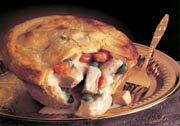
A trend in upscale New York restaurants today is serving higher quality soups. In Kansas City, chefs are raising the culinary bar with wonderful, flavorful liquid delights. Bright, colorful and exciting, these menu items are being finished tableside by skilled wait staff. Garnished with expensive ingredients, poured from crystal or silver pitchers, and created fresh daily by highly trained chefs, these soups mark a return to haute cuisine.
Customers are coming to expect, and demand, more than a tired, tepid bowl of French onion or cream of chicken soup. Curried Roast Pumpkin—garnished with green pumpkin seed oil; Wild Leek and Red Lentil—with baby fiddle fern; or, Miso Mushroom Wonton—served with a flight of three sakes—are concepts showing up regularly on menus. In every major city, chefs are returning to the foundation of great cuisine…that is, great soups. And every great chef knows all truly outstanding soups must begin with a properly made stock.

The Foundation
Stock is the flavorful liquid resulting from the proper extraction and concentration of fats, oils, juices and liquid compounds from various organic sources. Generally, bones, vegetables, meats and fishes are the primary components. Spices, herbs and aromatics often are added to create more complex flavors.In the mid 1970's, a 74-year-old Austrian Master Chef taught apprentices at a private club in Boston. There, over the course of a few years, Chef Bauhm taught the “144 basic sauces,” as well as the foundation of all culinary art. One of the original recipes given to the author by Chef Bauhm accompanies this article (see “Fond Brun” recipe). Compare this formula to a typical manufacturing formula used today. Obviously, the recipe is far too expensive for commercial use. However, soups made using this foundation as a beginning are incomparable. And, Starbucks Coffee (Seattle) has proven that a number of today's customers are ready to pay more for a clearly better product. Small “gourmet” manufacturers are beginning to respond to this demand for upscale products.
Cheryl Weatherly-Binnie is president of Copper Stockpot Inc. (Dallas, Tex.), a small “artisan” manufacturer of gourmet, organic stocks. Daughter of a Chicago Bears linebacker, Cheryl has the passion and drive her father showed on the gridiron. However, her passion is for traditionally prepared French food. Cheryl tells us that all the stocks produced by Copper Stockpot are hot packed, and then blast frozen. Weatherly-Binnie believes that retort processing alters the final flavor of stocks.
Retorted stocks generally are cooked at much higher temperatures than traditionally simmered fond (a French word for “stock”). Often heated to at least 250°F for a number of minutes, canned stocks undergo various changes during processing. Maillard reactions, caramelization and other heat-driven chemical changes take place, affecting final flavor and texture. Delicate flavors and aromas may become blended, muted or are lost entirely. Bright natural colors can fade or change, leaving shades of brown and gray. Proper freezing better preserves fresh taste, aroma, color and texture. (Editor's Note: Of course, retorted or even dry-blended products retain their popularity with consumers, restaurants and manufacturers for reasons beyond economics. Speed in preparation and more available storage space are two reasons.)
Teasing Out Texture
breaks down the cartilage, collagen, elastin and other connective tissues in meat. This process forms gelatin, which provides the body and texture found in a traditional fond. In fact, when chilled, a truly great fond literally can be cut with a knife. An old chef's saying goes something like this: How do you strain a good cold stock? You don't...You can't!A stock should be semi-solid when chilled. Stocks that have been stabilized with gums or starches cannot be used to create the same type of traditional glace or demi-glace via reduction. We have all seen such results at the local “all you can eat” buffet restaurant. No customer wants to see “chewy” gravy. No chef wants to serve a rubbery sauce. Classic fond-based sauces never experience such problems.
Classically speaking, there are three basic types of stock. However, there are actually four. Fish stock, or “Fume de Poisson,” is considered to be a separate category than fond because the techniques used are regarded as different. The list is as follows.
1. Fond Brun or Brown Stock.
2. Fond Blanc or White Stock.
3. Fond Maigre or Vegetable Stock.
4. Fume de Poisson or Fish Stock.
From these four “basics,” any number of gourmet soups and sauces can be built.
Restaurant chefs create stocks following a few common principles. They always begin with cold liquid. Natural clarification is used to create a clear “bright” final product. Impurities that rise to the surface and form a scum are skimmed off continually during cooking. A stock is simmered—never brought to a rolling boil. There are solid scientific principles behind each of these culinary rules.
Science Underpinnings
Starting a stock by using boiling “hot” water would save time. However, the heat causes blood and other compounds to coagulate within bones, sealing valuable compounds inside rather than slowly extracting them.
Using naturally occurring albumin and other proteins along with gentle convection currents to clarify the stock yields a far clearer and better tasting product than filtering the final liquid.
Skimming impurities from the surface of a developing stock removes particulates, fats and other compounds that may burn, create off flavors and poor texture. Texture, flavor and appearance are all improved.
Low-temperature simmering creates gentle convection currents that keep small particulates suspended, preventing the scorching that would occur if they were to settle to the bottom. Additionally, many heat-driven reactions are prevented or reduced.
Even Master Chef Auguste Escoffier, considered by some as the father of modern culinary arts, realized that once a perfect fond had been “brewed,” its flavor could then be improved by being “seasoned.” And, it would dramatically improve by the addition of a chemical flavor potentiator—sodium chloride—known as salt to most.
Today's research chef understands both the value of traditional, classical techniques and the reasons that these wonderful recipes have endured for centuries. A research chef understands the science behind why these products work. These chefs have learned to use food science to improve the classics. And, today's savvy food scientists can and should use understanding of classic culinary techniques to help them create better, more delicious new products.

Plus: A Tip on Flavor Enhancers
Even the most traditional chefs are aware of the value of taste “intensifiers,” though they may be hesitant to use them. A Certified Research Chef knows them all and knows when and how to use them! Chef John Matchuk CRC, CEC, with a flavor house, tells us that a few of the most common flavor potentiators are MSG, HVP, AYE, IMP, GMP and I+G. IMP and GMP are also referred to as disodium 5'-ribonucleotides, 5' prime nucleotides or 5' nucleotides. The ' is spoken as “prime.”MSG = monosodium glutamate
HVP = hydrolyzed vegetable protein
AYE = autolyzed yeast extract
IMP = disodium inosinate
GMP = disodium guanylate
I+G = IMP and GMP together
Knowing which one to use and when is the trick. The compounds most often are used with savory-type foods and are said to accentuate a “umami” sensory perception. Every good flavor company has a number of expert technical service people who can help.
Shaded Box: Beef Stock
(Standard/mass produced)
Beef bones 60Kg
Onions 3Kg
Carrot 3Kg
Celery 3Kg
Water 18Gal
Bayleaf 25g
Thyme 25g
Shaded Box: Fond Brun (A brown stock)
Beef bones 4Kg
Veal bones 3Kg
Duck thigh bones 2Kg
Beef oxtails 2Kg
Beef trim meat 1Kg
Pigs knuckles 1Kg
Calf's foot 1
Carrots 750g
Onions 500g
Leeks 400g
Celery 300g
Tomato paste 250g
Salt 100g
Garlic 50g
Water 40L
Bouquet-garni 1
Yield: approximately 30L *after reduction
Source: Recipe from Master Chef Bauhm